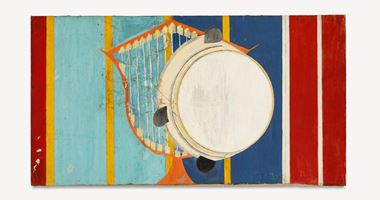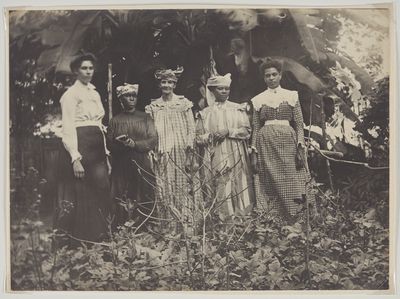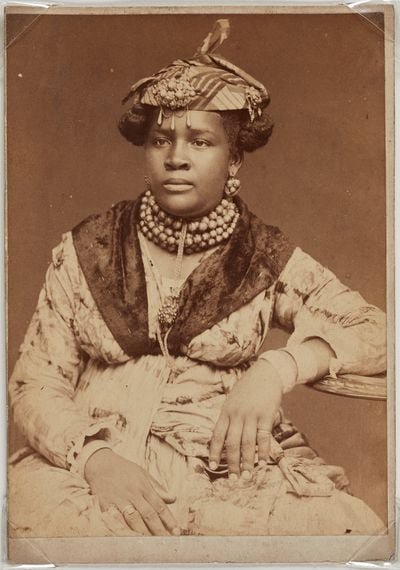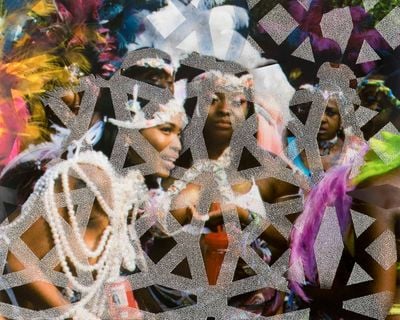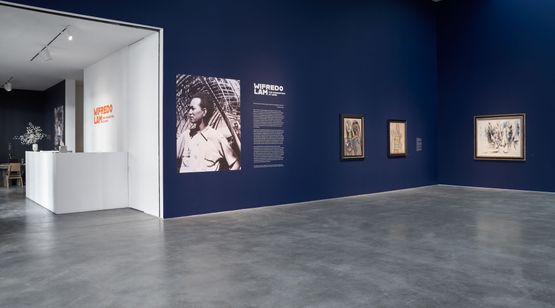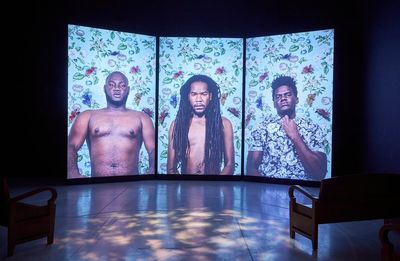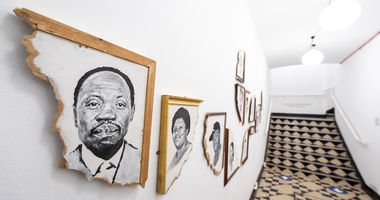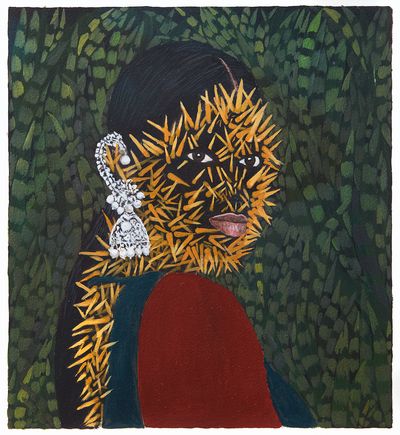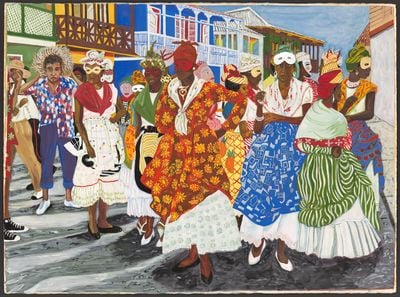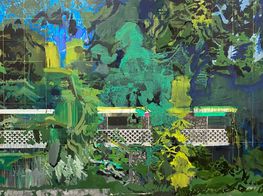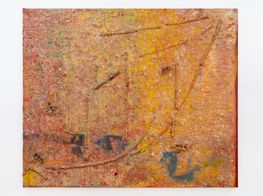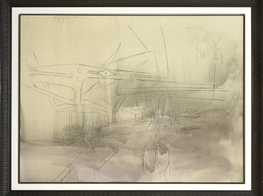Fragments of Epic Memory Centres the Caribbean and Its Diaspora

Nadia Huggins, Transformations No. 1 (2014). Digital photographs printed on ChromaLuxe. Overall: 76.2 x 118.1 cm. Courtesy the artist.
In a deft assemblage of artworks from across the Caribbean and its diaspora, Fragments of Epic Memory at the Art Gallery of Ontario in Toronto (AGO, 1 September 2021–21 February 2022) offers a rare opportunity to encounter the region's artistic expression in all its historical and cultural complexity.
Curated by Julie Crooks, head of the AGO's newly structured Department of Arts of Global Africa and the Diaspora, the exhibition puts the recently acquired Montgomery Collection of Caribbean Photographs in dialogue with over 30 artists of Caribbean descent who represent diverse geographical, cultural, and linguistic perspectives.
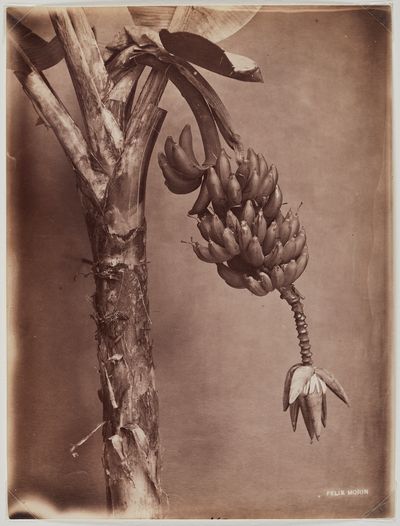
Modern and contemporary artworks by the likes of Sybil Atteck, Aubrey Williams, and June Clark, span the 19th-century period of post-emancipation in the Caribbean through to the 20th century and the present day.
Echoing the islands that make up the archipelago, the exhibition's title references St. Lucian poet Derek Walcott's 1992 Nobel Lecture of the same name, in which he argues that the history and everyday experiences of Caribbean peoples formed a unique culture, fused between the old and new worlds.
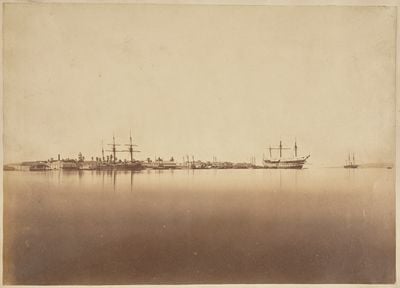
Walcott, who lived and worked most of his life in the Caribbean, viewed the art it produced as a 'restoration of our shattered histories, our shards of vocabulary, our archipelago becoming a synonym for pieces broken off from the original continent.'1
With Walcott's words in mind, the exhibition's videos, paintings, sculptures, and photographs seek to restore and reframe the Caribbean, pushing back against the colonial gaze found among selections from the Montgomery Collection's over 3,000 photographic artifacts showing the post-slavery and pre-independence period (1840–1940).
Interspersed amid the exhibition's artworks, the Montgomery images include portraits, landscapes, and other subjects captured by mostly unknown photographers whose work was used to entice prospective investors, speculators, and would-be property owners.
The first gallery opens to a large space anchored by wood and glass displays showing gelatin silver and albumen photographic prints of field labourers, indentured servants, men and women in cultural garments, churches, and post-emancipation landmarks. A sonic rebuttal to the Montgomery Collection's narrow version of history is transmitted through speakers, with the voice of Barbadian poet Kamau Brathwaite reading his seminal 1967 poem 'Calypso'.
It is through this interaction between past and present—structured by a dialectical positioning of voice, history, and identity—that the curatorial demonstrates 'how historical narratives, representation, and notions of freedom are constantly revisited, reimagined and reclaimed in different periods, underscoring the nuances that shape the artists from the Caribbean and its diaspora.'2
The spectres of history and memory are ever present in the first gallery. Guyanese-born British artist Sir Frank Bowling's acrylic and oil-based abstract painting Middle Passage (1970), placed prominently on a main wall in the first gallery, is a fiery, near-effervescent rendering of the horrors of the trans-Atlantic slave trade. Bright flashes of red and yellow consume faintly visible Black faces seen across the canvas, conjuring lives lost amid history's raging infernos.
British artist Hurvin Anderson's Rose Avenue (Drawing) (2006) challenges notions of the Caribbean pastoral, where the picturesque and sublime are oftentimes conflated with sunny idleness. In a three-part acrylic drawing, scenes of modest, white-walled homes are shown in leafy surroundings taken at different angles, suggesting a fondness for the triumvirate of intimacy, home, and community.
Fragments of Epic Memory is an expansive and intriguing multi-sensory site in which to examine intercultural and transnational artistic production.
Concern for ecological degradation is taken up in U.S. artist Andrea Chung's A Litany for Survival (2019), where cyanotype and sugar (a crop forever linked to the Caribbean) present a glittering blue seascape and coral reef. As sugar crystals fall imperceptibly from the artwork during the exhibition's run, the region's ecological and generative fragility is brought to the fore.
Reframing history through perspectives of spirituality and the legacies of migration is Wifredo Lam's oil and charcoal painting Mayombe (1962), where angular therianthropic figures derived from mixed Afro-Cuban beliefs visually repurpose and transform religions imposed through European conquest.
Along with other artists in the exhibition, Chung and Lam's presence makes clear the diversity and geo-cultural-historical intersections borne out of experiences of 19th-century Asian indentured labourers whose descendants have left an indelible imprint on Caribbean society.
A collection of video-based works creates a gateway between the first and second gallery space where the exhibition's themes move beyond the colonial gaze and focus on affirmations of identity, pride, and ongoing resistance.
In Trinidadian-born Nadia Huggins' two-channel video and sound installation In Circa no future (2016–2019), young boys are seen jumping from high cliffs and frolicking underwater, where the familiar is submerged and transformed. When the looped colour images are reversed in slow motion, the viewer is invited to reconsider notions of youth, agency, and freedom.
In Proverbs 24:10 (2008), Jamaican artist Peter Dean Rickards's hypnotic black and white three-channel video, young men perform dancehall moves in slow motion, thwarting stereotypes of loud bawdiness. Accompanied by a sombre song by singer/songwriter Nick Cave, the images challenge the viewer to contemplate the Caribbean's manifold visual and sonic registers.
Building on that concern for movement, Barbadian artist Alberta Whittle's three-channel video business as usual: hostile environment (2020) uses archival film and sound to convey the difficult circumstances and social conditions that Black people have endured as immigrants, focusing here on the Windrush generation, who continue to meet inhospitality and rejection in the U.K.
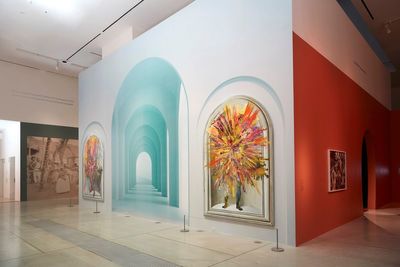
Turning to sculpture, Jamaican artist Charles Campbell's three-dimensional mat board and woodwork Maroonscape 1: Cockpit Archipelago (2019), presents a futuristic topographic map of Jamaica's Cockpit Country, a mountainous area in the country's northwest.
Campbell's layered, earth-coloured artwork pays homage to Jamaica's Blue Mountain maroon societies that resisted—and at times cooperated with—slave holders in order to achieve a form of autonomy, suggesting such fugitive strategies for survival may be required in distant epochs.
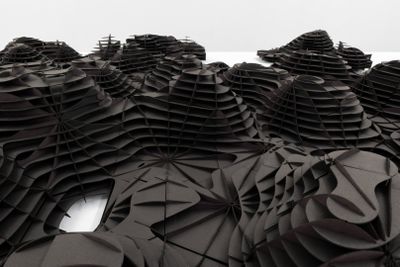
In the exhibition's second gallery, brightened lights reinforce themes of joy, strength, and perseverance. Danish-Trinidadian artist Jeannette Ehlers's black and white three-channel video Black Bullets (2012) projects silhouettes of school children walking in sentry-like formation along Haiti's famed Citadelle, a fortress built by former slaves to signify triumph over Europe's imperial tyranny.
Accompanied by heavy military drone-like sounds, the children's mirrored images move continuously from left to right, merging into bullets which are cast, ominously, for ongoing battles for freedom.
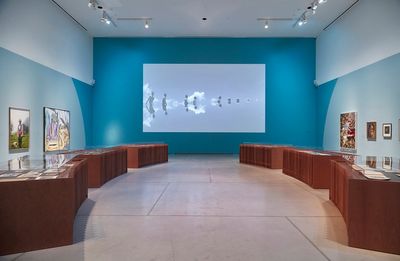
These battles extend to photographic artworks deployed here as counterpoints to the Montgomery Collection's colonial depictions. British photographer Vanley Burke's Boy with flag, Wilfred in Handsworth Park (1984) shows a young Black boy proudly displaying the Union Jack affixed to his bicycle amid the social unrest of 1980s Britain, projecting both innocence and resolve in the face of growing anti-Black sentiment.
In her gel medium photo transfer on wood triptych Feeding Trafalgar Square (2021), Canadian artist Sandra Brewster shows her Guyanese-born mother enjoying interactions with pigeons in front of a black and white image of the famous London landmark. The resulting juxtaposition, emphasised with blue colouring of her mother's coat, highlights West Indian claims of belonging to the body politic.

Reminiscent of characters in Samuel Selvon's satirical novel The Lonely Londoners (1956), Brewster's image alludes to generations of West Indians whose fraught presences nourished colonial centres while expanding the idea of who could belong to the nation state.
That dynamic of unfolding, expanding, and subverting tropes likewise resonates when the exhibition moves to subject matter typically associated with the Caribbean, as in the case of carnival, with clear intentions to elevate internal points of view. Gomo George's watercolour painting Women's Carnival Group (1996) shows women participating in carnival in all their vibrant colour and splendour, but their presence is grounded in close-knit celebration among the group rather than in spectacle for the onlooker.
Similarly, Paul Anthony Smith's ink-jet print Midnight Blue (2020) shows a woman dancing and masquerading as the Blue Devil, a carnival character who both plays and haunts amid revelry. Smith uses his 'picotage' technique that 'obscures his subjects with textural patterns and [limits] the access of those looking from the outside in.'3
Fragments of Epic Memory is an expansive and intriguing multi-sensory site in which to examine intercultural and transnational artistic production. Guided by a curatorial commitment that counters a reductionist reading of the region, the exhibition deepens our understanding of the Caribbean. —[O]
1 Walcott, Derek. Nobel Lecture. The Antilles: Fragments of Epic Memory (1992).
2 Exhibition introductory text, Fragments of Epic Memory, Art Gallery of Ontario (1 September 2021–21 February 2022).
3 Exhibition panel text for Midnight Blue (2020) by Paul Anthony Smith.

